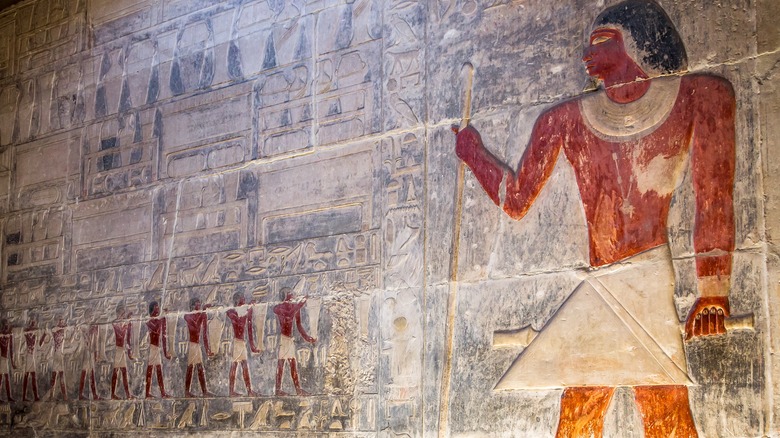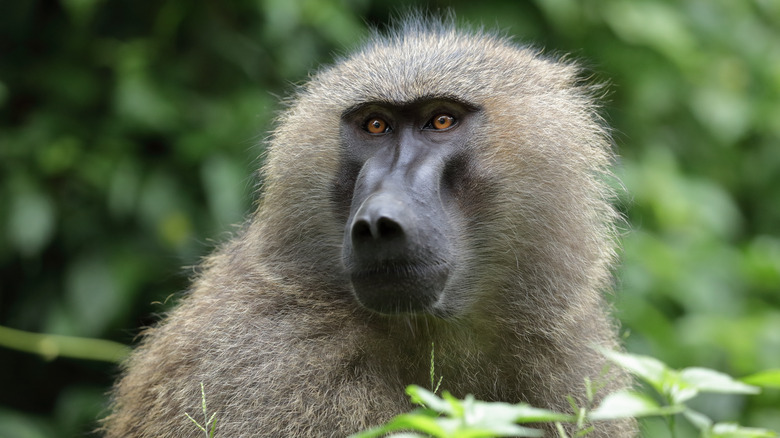The Unexpected Animal Ancient Egyptians Used As Early Police Dogs
Ancient Egypt was one of the most fascinating and enigmatic civilizations the world has ever seen. The ingenuity of this proud, pious, astonishingly knowledgeable society seemingly knew no bounds. The iconic Great Pyramid of Giza, for instance, was constructed over a period of around 20 years from 2580 B.C. (per World Atlas), and great minds have puzzled over how they managed this seemingly impossible feat for centuries.
Their inscrutable written language of hieroglyphs remained a mystery to us until the Rosetta Stone was found in 1799, per Britannica. The stone is an inscription of words from Ptolemy V Epiphanes, and the fact that its message was presented in both Greek and Egyptian allowed researchers to painstakingly decode the language. This proved a deep, intriguing dive into Ancient Egyptian society.
What a picture this new knowledge painted. Our eternal fascination with the people of Ancient Egypt has brought us all manner of intriguing knowledge, including the fact that a curious species of animal was seemingly used to apprehend law-breakers.
From cats to baboons
For the Ancient Egyptians, several different species of animal were of critical importance. Cats are perhaps the most famous example. In "Death, Power, and Apotheosis in Ancient Egypt: The Old and Middle Kingdoms," Julias Troche writes (per History) that Ancient Egyptians "saw animals as representations of divine aspects of their gods." Cats offered, as they do today, valuable friendship and hunting roles, but they also had divine meaning. Per Troche, feline friends in Egyptian art were "often depicted sitting under women's chairs, implying a connection to women, and perhaps fertility more broadly."
Various other fascinating creatures had great spiritual significance, including the baboon. According to Science, these noble creatures were linked with (among others) Amun-Ra and Thoth, some of Ancient Egypt's most powerful and respected deities. The tomb of Tutankhamun was decorated with artwork featuring baboons.
Much like cats, though, baboons also had an everyday significance in Egyptian society. They served with the law enforcement of the time.
Curious crimefighters: baboons on leads
According to Ancient Origins, the prominence of baboons in the spirituality of Ancient Egypt led to their becoming staples of art from throughout the long span of the civilization. They have reportedly been depicted (among various other activities) collecting pieces of fruit and pursuing fleeing criminals. Per The Archeologist, one piece of art from the Old Kingdom clearly shows a baboon with a tight grip on a person's leg, as though stopping the flight of the runner. The baboon is secured by a lead held by another person. This piece is now reportedly found in Cairo's Egyptian Museum, and it provides a fascinating insight into the society of the time.
Ancient Origins goes on to state that olive baboons and hamadryas baboons were seemingly still found in Egypt during the Old Kingdom. According to the study "Mummified baboons reveal the far reach of early Egyptian mariners" from Nathaniel J. Dominy et al (via eLife), "Two New Kingdom specimens of P. hamadryas were sourced to a region that encompasses much of present-day Ethiopia, Eritrea, and Djibouti, and portions of Somalia and Yemen." There was even, the abstract of the study goes on, "evidence of long-term residency in Egypt prior to mummification, consistent with a captive breeding program."
In short, baboons were a huge part of Ancient Egyptian life, and were seemingly imported accordingly. Not only were they associated with the divine, but they had a job to do.


